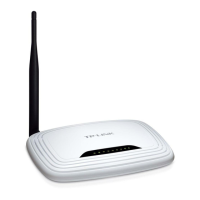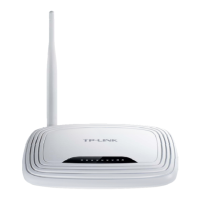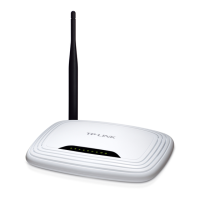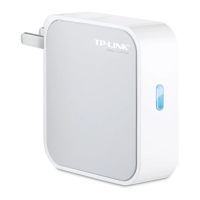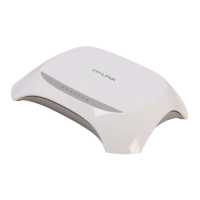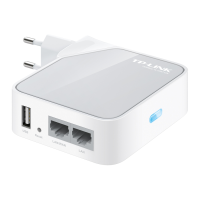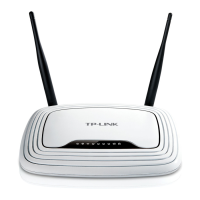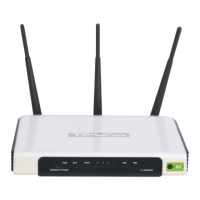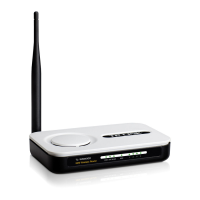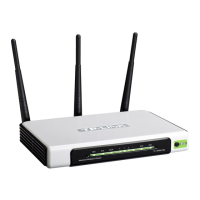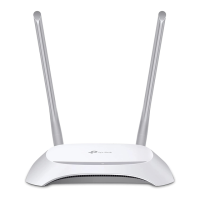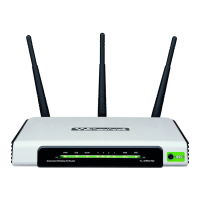Do you have a question about the TP-Link TL-WR741ND and is the answer not in the manual?
Describes the TP-LINK 150Mbps Wireless N Router, integrating switch, firewall, NAT-router, and AP.
Explains terminology and notes for the user guide, clarifying the use of TL-WR740N/TL-WR741ND.
Lists key features of the 150Mbps Wireless N Router, including speed, security, and connectivity options.
Details the front and rear panel components, including LEDs, buttons, and ports of the router.
Lists hardware and software prerequisites for installing and operating the router.
Specifies optimal placement and environmental conditions for the router's operation.
Provides step-by-step instructions for physically connecting the router to the modem and network.
Guides on setting up TCP/IP properties on a PC for router connectivity testing.
Walks users through the initial setup process using the router's web-based Quick Setup Wizard.
Explains how to log into the router's interface and view its status information.
Provides a step-by-step guide for initial router configuration using the Quick Setup Wizard.
Covers WAN, MAC Clone, and LAN settings for network connectivity and management.
Details wireless settings, security options, MAC filtering, and advanced wireless parameters.
Configures the DHCP server for automatic IP assignment and reserves specific IP addresses.
Explains firewall, VPN passthrough, DoS protection, parental, and access control settings.
Covers time settings, diagnostics, firmware upgrades, backups, reboots, and logs.
Step-by-step guide for setting up the router for ADSL users, including PPPoE connection.
Instructions for configuring the router for Ethernet users and MAC address cloning.
Guidance on configuring Virtual Server or DMZ Host for Netmeeting usage.
Defines terms like 802.11n, 802.11b, 802.11g, SSID, WEP, and Wi-Fi.
Explains terms such as DDNS, DHCP, DMZ, DNS, DSL, ISP, MTU, NAT, and PPPoE.
Steps to install and configure the TCP/IP protocol on Windows XP for network access.
Details standards, protocols, ports, frequency bands, data rates, security, and sensitivity.
Provides operating and storage temperature, and humidity requirements.
Describes the TP-LINK 150Mbps Wireless N Router, integrating switch, firewall, NAT-router, and AP.
Explains terminology and notes for the user guide, clarifying the use of TL-WR740N/TL-WR741ND.
Lists key features of the 150Mbps Wireless N Router, including speed, security, and connectivity options.
Details the front and rear panel components, including LEDs, buttons, and ports of the router.
Lists hardware and software prerequisites for installing and operating the router.
Specifies optimal placement and environmental conditions for the router's operation.
Provides step-by-step instructions for physically connecting the router to the modem and network.
Guides on setting up TCP/IP properties on a PC for router connectivity testing.
Walks users through the initial setup process using the router's web-based Quick Setup Wizard.
Explains how to log into the router's interface and view its status information.
Provides a step-by-step guide for initial router configuration using the Quick Setup Wizard.
Covers WAN, MAC Clone, and LAN settings for network connectivity and management.
Details wireless settings, security options, MAC filtering, and advanced wireless parameters.
Configures the DHCP server for automatic IP assignment and reserves specific IP addresses.
Explains firewall, VPN passthrough, DoS protection, parental, and access control settings.
Covers time settings, diagnostics, firmware upgrades, backups, reboots, and logs.
Step-by-step guide for setting up the router for ADSL users, including PPPoE connection.
Instructions for configuring the router for Ethernet users and MAC address cloning.
Guidance on configuring Virtual Server or DMZ Host for Netmeeting usage.
Defines terms like 802.11n, 802.11b, 802.11g, SSID, WEP, and Wi-Fi.
Explains terms such as DDNS, DHCP, DMZ, DNS, DSL, ISP, MTU, NAT, and PPPoE.
Steps to install and configure the TCP/IP protocol on Windows XP for network access.
Details standards, protocols, ports, frequency bands, data rates, security, and sensitivity.
Provides operating and storage temperature, and humidity requirements.
| Full duplex | Yes |
|---|---|
| VPN support | PPTP/L2TP/IP Sec VPN Pass-through |
| Cabling technology | 10/100Base-T(X) |
| Networking standards | IEEE 802.11b, IEEE 802.11g, IEEE 802.11n, IEEE 802.3, IEEE 802.3u |
| Ethernet LAN data rates | 10, 100 Mbit/s |
| Ethernet LAN interface type | Fast Ethernet |
| Ethernet LAN (RJ-45) ports | 4 |
| Power over Ethernet (PoE) | No |
| Power consumption (typical) | 7 W |
| Input current | 0.85 A |
| Frequency range | 2.4 - 2.4835 GHz |
| Operating temperature (T-T) | 32 - 113 °F |
| WLAN data transfer rates supported | 11, 54, 150 Mbit/s |
| Product color | Black, White |
| Storage temperature (T-T) | -40 - 70 °C |
| Storage relative humidity (H-H) | 5 - 95 % |
| Operating relative humidity (H-H) | 10 - 90 % |
| Security algorithms | 128-bit WEP, 64-bit WEP, WPA, WPA-PSK, WPA2, WPA2-PSK |
| Antennas quantity | 1 |
| Antenna gain level (max) | 5 dBi |
| Modulation | 16-QAM, 64-QAM, CCK, DBPSK, DQPSK, OFDM |
| Wi-Fi standards | 802.11b, 802.11g, Wi-Fi 4 (802.11n) |
| Top Wi-Fi standard | Wi-Fi 4 (802.11n) |
| WLAN data transfer rate (max) | 150 Mbit/s |
| Depth | 118 mm |
|---|---|
| Width | 174 mm |
| Height | 33 mm |
| Weight | - g |
